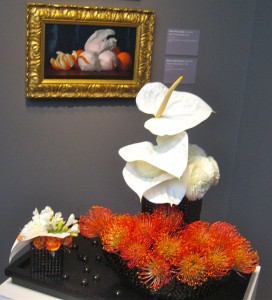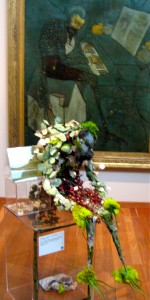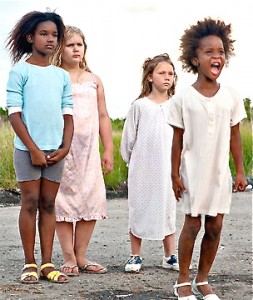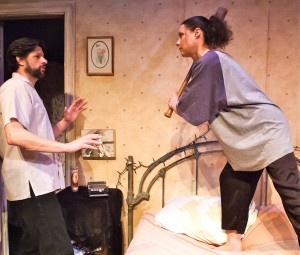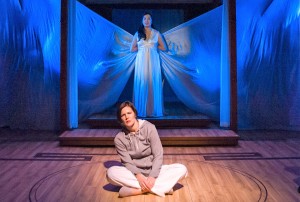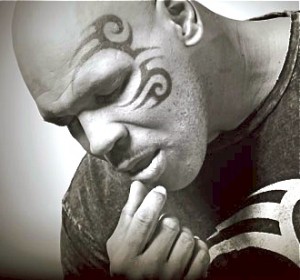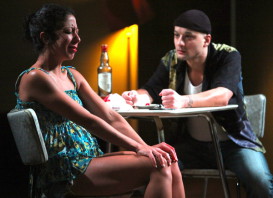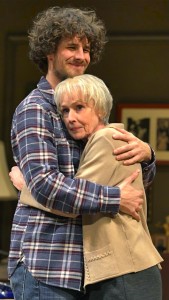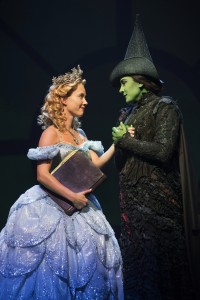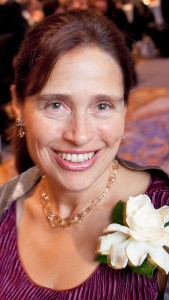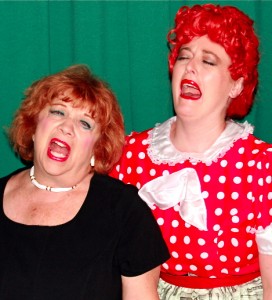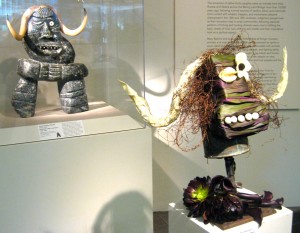
Floral materials (forefront) burlesque American Art piece in “Bouquets to Art.” exhibit. Photo: Woody Weingarten.
Floral art sits in front of Whistler’s “The Gold Scab” in de Young’s “Bouquets to Art.” Photo: Woody Weingarten
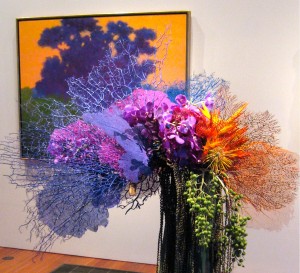
Colorful creation by Waterlily Pond Floral Design Studio (Natasha Lisistsa and Carla Parkinson) mirrors the tree of Richard Mayhew’s “Rhapsody.” Photo: Woody Weingarten.
Risking being taunted as a wretched pun-tificaotr, I hereby affirm that the de Young’s floral-art exhibit unearths how great it is when artisans put their mettle to the petal.
Truly.
“Bouquets to Art,” a vital though short-lived array at that San Francisco museum, colorfully blossoms each year like a perennial.
The gestalt of this year’s parade of flora is much more vibrant than any of its component blooms — and the work of more than 125 exhibitors as a whole is as compelling as any of its 28 annual predecessors.
Skeptics beware: Floral art can dynamically complement oils and sculptures.
The two-floored 2013 display, where each artist (or group of floral designers) is inspired by an individual piece of the permanent collection to create a tribute to that art, can comfortably be covered in a few hours. But expect your ears to be filled during that brief visit with glowing, gushing commentaries from other guests — art lovers, floral lovers, “Bouquets to Art” lovers.
This year’s exhibit provides sharper contrasts than usual.
Why?
Ultra-simple arrangements vie for attention with complicated constructions.
Monochromatic wonders compete with glitzy, sparkly thingies (yes, art snobs may quake in their finery at my use of such a slangy term — and my tinge of derision).
And fancy draped fabric, string and high-wire acts steal the floodlights of more modest interpretations — impressionistic or realistic — of fine art.
My favorite is by Half Moon Flowers (Leila Simms), a homage to James McNeill Whistler’s 1879 “The Gold Scab: Eruption in Filthy Lucre (The Creditor),” an unusual dark painting that caricatures Whistler’s benefactor.
The floral display ideally mimics the artwork in both tone and color.
Since whimsy was under-represented this year, I was particularly happy to find an American Art burlesque by violetta (arlene boyle) of a head with horns.
“Bouquets” always acts as a reminder to me of how fleeting life is — and how lasting art can be.
Most of the flowers — like the sand sculptures created on a beach only to have the waves wash them away shortly after they’re built — survive only a few days (some must be replenished daily), while the paintings and sculptures they represent are, well, a lot more permanent.
So, if require additional reassurance about longevity when you finish your tour, you might wander downstairs to another exhibit, “Girl with a Pearl Earring,” subtitled “Dutch Paintings from the Mauritshuis.”
That display features the famed 1665 Vermeer oil on canvas. But if that and its companion pieces don’t satisfy your quest for classics, try the tangential exhibit of “Rembrandt’s Century,” which features 200 smaller works (including rarely seen Rembrandt depictions of homelessness and poverty).
Though you must rush to catch “Bouquets to Art,” you can be a little more leisurely with “Girl” and “Rembrandt” — those shows will run through June 2.
“Bouquets to Art” runs through March 23 at the de Young, 50 Hagiwara Tea Garden Drive at John F. Kennedy Drive, in San Francisco’s Golden Gate Park. Tickets: Free for members and children under 5, $20 adults, $17 seniors (over 65), $16 youths (6-17). Information: (415) 750-3600 or contact@famsf.org.


